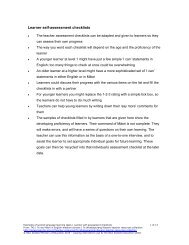Teacher Assessment Checklists - Te reo MÄori
Teacher Assessment Checklists - Te reo MÄori
Teacher Assessment Checklists - Te reo MÄori
Create successful ePaper yourself
Turn your PDF publications into a flip-book with our unique Google optimized e-Paper software.
Learner can write the names of the names ofthe monthsLearner knows that numbers and the names ofdays and months are combined to make datesLearner can understand dates while listeningLearner can understand dates while readingLearner can say the dateLearner can write the date in words andnumeralsLearner can interpret dates from a diary orcalendar in Māori1.4 communicate aboutpersonal information,such as name, iwi,hapū, mountain andriver; or hometown andplace of origin;1.5 communicate aboutlocation;Learner can understand his or her own namewhen listeningLearner can understand other names whenlisteningLearner can read his or her own name when itis writtenLearner can read familiar namesLearner can say his or her own nameLearner can say the names of people he orshe knowsLearner can write his or her own nameLearner can understand age information whenlisteningLearner can understand age information whenreadingLearner can tell others their own ageLearner can speak about the age of otherpeople and thingsLearner can write down his or her age in wordsLearner can write about the age of otherpeople and thingsLearner can understand information aboutwhere people are from when listeningLearner can read and understand informationabout where people are fromLearner can say where people are fromLearner can write where people are fromLearner knows the Māori names for personallyrelevant places in New ZealandLearner knows the Māori names of personallyrelevant countriesLearner can understand basic information onlocation in space when listeningLearner can understand basic information onlocation in space when readingLearner can convey basic information onlocation in space when speakingLearner can convey basic information onlocation in space when writingLearner can understand and convey simpleinformation about where people and things arecurrently locatedExamples of second language learning tasks | <strong><strong>Te</strong>acher</strong> <strong>Assessment</strong> <strong>Checklists</strong> 2 of 29From: TKI | <strong>Te</strong> <strong>reo</strong> Māori in English-medium schools | <strong>Te</strong> Whakaipurangi Rauemi teacher resources collectionhttp://te<strong>reo</strong>maori.tki.org.nz/<strong><strong>Te</strong>acher</strong>-resources/<strong>Te</strong>-Whakaipurangi-Rauemi-teacher-resources-collection© New Zealand Ministry of Education 2010 – copying restricted to use by the New Zealand education sector
1.6 understand and usesimple politenessconventions (forexample, ways ofacknowledging people,expressing regret, andcomplimenting people);1.7 use and respond tosimple classroomlanguage (includingasking for the word toexpress something in te<strong>reo</strong> Māori).Whakarongo –ListeningBy the end of level 1,learners can:identify the sounds ofletters of the Māorialphabet, lettercombinations,intonation, and stresspatterns;recognise andunderstand simple,familiar spoken words,phrases, andsentences.Learner can understand simple politenessconventions when listeningLearner can understand simple politenessconventions when reading (eg the greetings /mihi in a letter or an invitation)Learner can use simple politeness conventionswhen speakingLearner can use simple politeness conventionswhen writing (eg in a simple personal letter)Learner can thank people at a basic levelLearner knows how to apologise at a basiclevelLearner knows how to excuse themselves at asimple level from a situation or for a mistake orpoor behaviourLearner knows how to pay simple complimentsLearner can understand simple classroomstatements when listeningLearner can understand basic classroominstructions when listeningLearner can understand simple classroomstatements when readingLearner can understand basic classroominstructions when readingLearner can express simple classroomstatements when speakingLearner can express basic classroominstructions when speakingLearner can express simple classroomstatements when writingLearner can express basic classroominstructions when writingLearner can understand simple requests forinformation in the classroomLearner can respond to requests for basicinformation in the classroom contextLearner can identify the sounds of theconsonants and vowels of Māori whenlisteningLearner can recognise the difference betweenshort and long vowels when listeningLearner can recognise consonant and singlevowel sequences when listening (eg ka, ko, ki)Learner can identify sound combinations whenlistening (eg syllables, vowel combinations:whā, whai, ngau, hea, kua, pau)Learner can distinguish minimal pairs whenlistening (eg: tai, tae; hou, hau)Learner can recognise different intonationpatterns when listeningLearner can recognise word stress whenlisteningLearner can recognise phrase and utterance orsentence stress when listeningExamples of second language learning tasks | <strong><strong>Te</strong>acher</strong> <strong>Assessment</strong> <strong>Checklists</strong> 3 of 29From: TKI | <strong>Te</strong> <strong>reo</strong> Māori in English-medium schools | <strong>Te</strong> Whakaipurangi Rauemi teacher resources collectionhttp://te<strong>reo</strong>maori.tki.org.nz/<strong><strong>Te</strong>acher</strong>-resources/<strong>Te</strong>-Whakaipurangi-Rauemi-teacher-resources-collection© New Zealand Ministry of Education 2010 – copying restricted to use by the New Zealand education sector
Learner can recognise and understand simple,familiar spoken wordsLearner can recognise and understand simple,familiar phrasesLearner can recognise and understand simple,familiar sentencesPānui – ReadingBy the end of level 1,learners can:identify letters of theMāori alphabet(arapū), lettercombinations, basicwritten languageconventions, andsimple punctuation;recognise andunderstand simple,familiar written words,phrases, andsentencesMātakitaki – ViewingBy the end of level 1,learners can:recognise thecommunicativesignificance ofparticular facialexpressions and otherbody language;interpret meaningsthat are conveyed incombinations of wordsand images orsymbolsKōrero – SpeakingBy the end of level 1,learners can:imitate thepronunciation,intonation, stress, andrhythm of Māoriwords, phrases, andsentences;respond appropriatelyto simple, familiarinstructions, andsimple questions;ask simple questions;initiate spokenencounters in te <strong>reo</strong>Māori, using simplegreetings, questions,Learner can identify the letters of the Māorialphabet when readingLearner can identify letter and soundcombinations when readingLearner can distinguish minimal pairs whenreading (eg: tai, tae; hou, hau)Learner can recognise basic written languageconventionsLearner can use basic punctuation such asmacrons, commas, full stops and questionmarks, capital and lower case lettersLearner can recognise and understand simple,familiar written wordsLearner can recognise and understand simple,familiar written phrasesLearner can recognise and understand simple,familiar written sentencesLearner can recognise the communicativesignificance of particular facial expressionsand other body languageFacial expressions and body languageintroduced:......................................................................................................................Learner can interpret meanings that areconveyed in combinations of words andimages or symbols.Visual texts introduced:............................................................................................................................Learner can produce the sounds of individualMāori consonants and vowels when speakingLearner can produce the difference betweenshort and long vowels when speakingLearner can produce consonant and singlevowel sequences when speaking (eg ka, ko,ki)Learner can produce sound combinationswhen speaking (eg syllables, vowelcombinations)Learner can distinguish minimal pairs whenspeaking (eg tai, tae; hou, hau)Learner can produce different intonationpatterns at a basic level when speakingLearner can produce simple, familiar spokenwordsLearner can produce simple, familiar spokenwords, with appropriate word stressExamples of second language learning tasks | <strong><strong>Te</strong>acher</strong> <strong>Assessment</strong> <strong>Checklists</strong> 4 of 29From: TKI | <strong>Te</strong> <strong>reo</strong> Māori in English-medium schools | <strong>Te</strong> Whakaipurangi Rauemi teacher resources collectionhttp://te<strong>reo</strong>maori.tki.org.nz/<strong><strong>Te</strong>acher</strong>-resources/<strong>Te</strong>-Whakaipurangi-Rauemi-teacher-resources-collection© New Zealand Ministry of Education 2010 – copying restricted to use by the New Zealand education sector
and statements.Tuhituhi – WritingBy the end of level 1,learners can:write letters andnumbers;write vowels withmacrons;reproduce lettercombinations andpunctuation for Māoriwords, phrases, andsentences in familiarcontexts;write simple, familiarwords, phrases, andsentences using theconventions of writtenlanguage, such asappropriate spellingand punctuation.Whakaatu –PresentingBy the end of level 1,learners can:use appropriate facialexpressions, bodylanguage and imagesto convey messages(with and withoutaccompanying verballanguage);use selected featuresof visual language toadd meaning to simplewritten/oral text.Learner can produce familiar phrasesLearner can produce simple, familiarutterances or sentencesLearner can produce familiar phrases andutterances with appropriate stress whenspeakingLearner can ask simple questionsLearner can produce simple greetingsLearner can produce simple statementsLearner can issue simple instructionsLearner can respond to simple, familiarinstructionsLearner can respond to simple, familiarquestionsLearner can write down the letters of the Māorialphabet (eg when these are spoken)Learner can write vowels with macronsLearner can write letter combinations andwords, including macrons, to produce familiarwords, phrases, and sentences in familiarcontextsLearner can write letter combinations andwords, phrases, and sentences in familiarcontexts using appropriate punctuation andaccurate spellingLearner can write the numbers 1 to 100 innumerals (eg when these are read to them)Learner can write the numbers 1 to 100 inwordsLearner can use appropriate facialexpressions, body language and images toconvey messages (with and withoutaccompanying verbal language)Learner can use selected features of visuallanguage to add meaning to simple spokentextFeatures introduced: .....................................................................................................................................................Learner can use selected features of visuallanguage to add meaning to simple written textFeatures introduced:..........................................................................................................................Examples of second language learning tasks | <strong><strong>Te</strong>acher</strong> <strong>Assessment</strong> <strong>Checklists</strong> 5 of 29From: TKI | <strong>Te</strong> <strong>reo</strong> Māori in English-medium schools | <strong>Te</strong> Whakaipurangi Rauemi teacher resources collectionhttp://te<strong>reo</strong>maori.tki.org.nz/<strong><strong>Te</strong>acher</strong>-resources/<strong>Te</strong>-Whakaipurangi-Rauemi-teacher-resources-collection© New Zealand Ministry of Education 2010 – copying restricted to use by the New Zealand education sector
someone else is feelingLearner has a wider range of ways ofdescribing feelingsWhakarongo –ListeningBy the end of level 2,learners can:identify sounds of lettersof the Māori alphabet,letter combinations,intonation, and stresspatterns;recognise andunderstand familiarspoken words even insome unfamiliar contexts;understand a range ofshort oral textscontaining familiarphrases and sentences;get the gist of slightlymore complex or lessfamiliar te <strong>reo</strong> Māoriphrases and sentences.Pānui – ReadingBy the end of level 2,learners can:identify letters of theMāori alphabet, lettercombinations, and simplepunctuation;recognise andunderstand simple,familiar written words,phrases, and sentences;understand short writtentexts consisting offamiliar <strong>reo</strong> Māori words,phrases, and sentences;get the gist of slightlymore complex or lessfamiliar <strong>reo</strong> Māoriphrases and sentences.Mātakitaki – ViewingBy the end of level 2,learners can:respond appropriately tomeanings conveyedthrough selected visualtexts;understand and respondto combinations of visualand verbal language inselected texts.Learner can identify the sounds of Māori,and sound combinations when listeningLearner can identify intonation, and stresspatternsLearner can recognise and understandfamiliar spoken words in familiar contextsLearner can recognise and understandfamiliar spoken words in some unfamiliarcontextsLearner can understand a range of shortspoken texts containing familiar phrasesand sentencesLearner can get the gist of slightly morecomplex or less familiar spoken phrasesand sentencesLearner can identify letters of the Māorialphabet, letter combinations, and simplepunctuationLearner can recognise and understandsimple, familiar written words, phrases, andsentencesLearner can understand short written textsconsisting of familiar Māori words, phrases,and sentencesLearner can get the gist of slightly morecomplex or less familiar Māori phrases andsentences.Learner can respond appropriately tomeanings conveyed through selectedvisual textsVisual texts introduced:............................................................................................................................Learner can understand and respond tocombinations of visual and verbal languagein selected textsVisual texts introduced:............................................................................................................................Examples of second language learning tasks | <strong><strong>Te</strong>acher</strong> <strong>Assessment</strong> <strong>Checklists</strong> 7 of 29From: TKI | <strong>Te</strong> <strong>reo</strong> Māori in English-medium schools | <strong>Te</strong> Whakaipurangi Rauemi teacher resources collectionhttp://te<strong>reo</strong>maori.tki.org.nz/<strong><strong>Te</strong>acher</strong>-resources/<strong>Te</strong>-Whakaipurangi-Rauemi-teacher-resources-collection© New Zealand Ministry of Education 2010 – copying restricted to use by the New Zealand education sector
Kōrero – SpeakingBy the end of level 2,learners can:begin to usepronunciation, intonation,stress, and rhythm foremphasis and to clarifymeaning;respond appropriately tosimple, familiarinstructions and simplequestions;ask simple questions andgive simple information;initiate simpleconversations in te <strong>reo</strong>Māori.Tuhituhi – WritingBy the end of level 2,learners can:write simple, familiarwords, phrases, andsentences using spellingand punctuationconventions;write simple te <strong>reo</strong> Māorimessages;write a series ofsentences in te <strong>reo</strong> Māoridescribing theappearance orcharacteristics ofsomething.Whakaatu – PresentingBy the end of level 2,learners can:produce visual texts topresent informationand/or ideas;combine visual andverbal language topresent informationand/or ideas.Learner is beginning to use pronunciationfor emphasis and to distinguish meaningLearner is beginning to use intonation foremphasis and to distinguish meaningLearner is beginning to use stress andrhythm for emphasis and to distinguishmeaningLearner can respond appropriately tosimple, familiar instructionsLearner can respond to simple questionsLearner can ask simple questionsLearner can give simple informationLearner can initiate simple conversationsLearner can write simple, familiar words,phrases, and sentences using spelling andpunctuation conventionsLearner can convey simple messages inwritingLearner can write a series of sentencesdescribing the appearance of something.Learner can write a series of sentencesdescribing the characteristics of something.Learner can also write the following:............................................................................................................................................................................................................................................................................................................Learner can produce visual texts to presentinformationLearner can produce visual texts to presentideasLearner can combine visual and verballanguage to present informationLearner can combine visual and verballanguage to present ideasVisual texts produced by this learner:............................................................................................................................................................................................................................................................................................................Examples of second language learning tasks | <strong><strong>Te</strong>acher</strong> <strong>Assessment</strong> <strong>Checklists</strong> 8 of 29From: TKI | <strong>Te</strong> <strong>reo</strong> Māori in English-medium schools | <strong>Te</strong> Whakaipurangi Rauemi teacher resources collectionhttp://te<strong>reo</strong>maori.tki.org.nz/<strong><strong>Te</strong>acher</strong>-resources/<strong>Te</strong>-Whakaipurangi-Rauemi-teacher-resources-collection© New Zealand Ministry of Education 2010 – copying restricted to use by the New Zealand education sector
<strong>Assessment</strong> checklist for Level 3 Achievement ObjectivesLEVEL 3AchievementObjective<strong><strong>Te</strong>acher</strong> assessment checklist itemsLearner’s name:Date of assessment:Rating1 / 2 / 3Comments:say more aboutwhat the learnercan or cannot do3.1 communicate,including comparing andcontrasting, about habits,routines and customs;Learner can describe habitsLearner can describe routinesLearner can compare and contrast habitsLearner can compare and contrast routines3.2 communicate aboutevents and where theytake place;Learner can relate information about eventshe or she has been involved inLearner can relate information about eventshe or she is currently involved inLearner can relate events he or she plans tobe involved inLearner can relate information about eventsothers have been involved inLearner can relate information about whereevents take place3.3 give and followdirections;Learner can give simple directions to alocationLearner can give more complex directionsto a locationLearner can use a map to give directions toa locationLearner can give simple directions tocomplete a taskLearner can give more complex directionsto complete a taskLearner can follow simple directions to alocationLearner can follow more complex directionsto a locationLearner can use a map to follow directionsto a locationLearner can follow simple directions tocomplete a taskLearner can follow more complex directionsto complete a task3.4 communicate,including comparing andcontrasting, about howpeople travel;Learner can convey information about howhe or she travels to familiar destinationsLearner can convey information about howothers travel to familiar destinationsLearner knows relevant vocabulary formodes of transportLearner can express comparisons andcontrasts about how people travelLearner can provide information based ontimetables and brochuresLearner can interpret information fromtimetables and brochuresExamples of second language learning tasks | <strong><strong>Te</strong>acher</strong> <strong>Assessment</strong> <strong>Checklists</strong> 9 of 29From: TKI | <strong>Te</strong> <strong>reo</strong> Māori in English-medium schools | <strong>Te</strong> Whakaipurangi Rauemi teacher resources collectionhttp://te<strong>reo</strong>maori.tki.org.nz/<strong><strong>Te</strong>acher</strong>-resources/<strong>Te</strong>-Whakaipurangi-Rauemi-teacher-resources-collection© New Zealand Ministry of Education 2010 – copying restricted to use by the New Zealand education sector
3.5 communicate aboutimmediate past activities.Whakarongo –ListeningBy the end of level 3,learners can:understand specificdetail and overallmeaning in familiarcontexts and in someunfamiliar contexts;understand a range ofshort oral textsconsisting mainly offamiliar language;get the gist of shortoral texts that containsome unfamiliarlanguage.Pānui – ReadingBy the end of level 3,learners can:understand specificdetail and overallmeaning in a range ofshort written textsconsisting mainly offamiliar language;get the gist of shortwritten texts thatcontain someunfamiliar language.Learner can convey information about whathe or she has just done, or done recentlyLearner can convey information about whatothers have just done, or done recentlyLearner can understand specific detail infamiliar contexts when listeningLearner can understand overall meaning infamiliar contexts when listeningLearner can understand specific detail insome unfamiliar contexts when listeningLearner can understand overall meaning insome unfamiliar contexts when listeningLearner can understand a range of shortspoken texts consisting mainly of familiarlanguageTypes of spoken texts familiar to thislearner:........................................................................................................................................................................................................................................................Learner can get the gist of short spokentexts that contain some unfamiliar languageLearner can understand specific detail in arange of short written texts consistingmainly of familiar languageLearner can understand overall meaning ina range of short written texts consistingmainly of familiar languageTypes of written texts familiar to this learner:........................................................................................................................................................................................................................................................Learner can get the gist of short writtentexts that contain some unfamiliar languageMātakitaki – ViewingBy the end of level 3,learners can:identify and respond tosome visual and verbalfeatures of texts, andthe ways thesefeatures interact forparticular purposes;understand andrespond to a range offeatures in selectedvisual texts.Kōrero – SpeakingBy the end of level 3,learners can:initiate and sustainLearner can identify and respond to somevisual and verbal features of texts, and theways these features interact for particularpurposesLearner can understand and respond to arange of features in selected visual texts.Visual texts introduced:.........................................................................................................................................................................................................................................................Learner can initiate short conversationsLearner can sustain short conversationsLearner can give short prepared talks onfamiliar topicsExamples of second language learning tasks | <strong><strong>Te</strong>acher</strong> <strong>Assessment</strong> <strong>Checklists</strong> 10 of 29From: TKI | <strong>Te</strong> <strong>reo</strong> Māori in English-medium schools | <strong>Te</strong> Whakaipurangi Rauemi teacher resources collectionhttp://te<strong>reo</strong>maori.tki.org.nz/<strong><strong>Te</strong>acher</strong>-resources/<strong>Te</strong>-Whakaipurangi-Rauemi-teacher-resources-collection© New Zealand Ministry of Education 2010 – copying restricted to use by the New Zealand education sector
short conversations;give short preparedtalks on familiar topics;use generallyappropriatepronunciation, stress,rhythm, and intonation;express simple originalideas;describe familiarevents, people, andthings.Tuhituhi – WritingBy the end of level 3,learners can:use resources (forexample, dictionariesand glossaries) toexperiment with somenew language inwriting and to checkspelling;prepare and write shorttexts on familiar topics;write simple personalletters and emails;use appropriate writingconventions.Whakaatu – PresentingBy the end of level 3,learners can:present texts in whichvisual and verbalfeatures interact toproduce particularmeanings and effects;present/perform akōrero pūrakau,whakataukī, pepeha orwaiata making effectiveuse of visual languagefeatures.Learner can use generally appropriatepronunciation, stress, rhythm, andintonationLearner can express simple original ideasLearner can describe familiar eventsLearner can describe familiar peopleLearner can describe familiar things.Learner can use resources (eg dictionariesand glossaries) to experiment with somenew language in writing and to checkspellingResources used by this learner:...................................................................................................................................................................................Learner can prepare and write short textson familiar topicsFamiliar topics for this learner:....................................................................................................................................................................................Learner can write simple personal lettersLearner can write simple personal emailsLearner can use appropriate writingconventionsLearner can also write the following:................................................................................................................................................................................................................................................Learner can present texts in which visualand verbal features interact to produceparticular meanings and effectsLearner can present or perform a legendthat pays attention to visual languagefeaturesLearner can present or perform awhakataukī that pays attention to visuallanguage featuresLearner can present or perform a pepehathat pays attention to visual languagefeaturesLearner can present or perform a waiatathat pays attention to visual languagefeaturesVisual texts produced by this learner:.......................................................................................................................................................................................Examples of second language learning tasks | <strong><strong>Te</strong>acher</strong> <strong>Assessment</strong> <strong>Checklists</strong> 11 of 29From: TKI | <strong>Te</strong> <strong>reo</strong> Māori in English-medium schools | <strong>Te</strong> Whakaipurangi Rauemi teacher resources collectionhttp://te<strong>reo</strong>maori.tki.org.nz/<strong><strong>Te</strong>acher</strong>-resources/<strong>Te</strong>-Whakaipurangi-Rauemi-teacher-resources-collection© New Zealand Ministry of Education 2010 – copying restricted to use by the New Zealand education sector
<strong>Assessment</strong> checklist for Level 4 Achievement ObjectivesLEVEL 4AchievementObjective<strong><strong>Te</strong>acher</strong> assessment checklist itemsLearner’s name:Date of assessment:Rating1 / 2 / 3Comments:say more aboutwhat the learnercan or cannot do4.1 request, offer, accept,and decline things,invitations, andsuggestions;Learner can make requestsLearner can make offersLearner can accept things, invitations,suggestionsLearner can decline things, invitations,suggestions4.2 communicate aboutplans for the immediatefuture;Learner can express what he or she isabout to doLearner can express his or her plans for theimmediate future4.3 communicate aboutobligations andresponsibilities;Learner can express his or her obligationsLearner can express his or herresponsibilitiesLearner can express what others a<strong>reo</strong>bliged to doLearner can express what others areresponsible for4.4 give and seekpermission or agreement;Learner can give permission to othersLearner can ask for permission4.5 communicate aboutthe quality, quantity, andcost of things.Learner can convey information about thequality of thingsLearner can convey information aboutgeneral quantityLearner can convey information aboutspecific quantitiesLearner can convey information about thegeneral cost of thingsLearner can convey information about thespecific cost of things using moneyexpressions (dollars and cents)Whakarongo – ListeningBy the end of level 4,learners can:make use of context andfamiliar language to workout meaning andrelationships betweenthings, events, andideas;understand specificdetails in contexts thatmay contain someunfamiliar language.Learner can make use of context andfamiliar language when listening, to workout meaning of less familiar itemsLearner can make use of context andfamiliar language when listening, to workout relationships between things, events,and ideasLearner can understand specific details inspoken contexts that may contain someunfamiliar languagePānui – ReadingBy the end of level 4,learners can:understand a range ofLearner can understand a range of shortwritten texts that consist mainly of familiarlanguageWritten texts understood by this learner:Examples of second language learning tasks | <strong><strong>Te</strong>acher</strong> <strong>Assessment</strong> <strong>Checklists</strong> 12 of 29From: TKI | <strong>Te</strong> <strong>reo</strong> Māori in English-medium schools | <strong>Te</strong> Whakaipurangi Rauemi teacher resources collectionhttp://te<strong>reo</strong>maori.tki.org.nz/<strong><strong>Te</strong>acher</strong>-resources/<strong>Te</strong>-Whakaipurangi-Rauemi-teacher-resources-collection© New Zealand Ministry of Education 2010 – copying restricted to use by the New Zealand education sector
short written texts thatconsist mainly of familiarlanguage;understand overallmeaning and specificdetail in contexts thatmay contain someunfamiliar language;guess the meanings ofunfamiliar words andphrases used in familiarcontexts.Mātakitaki – ViewingBy the end of level 4,learners can:identify particularfeatures of visuallanguage andunderstand theirsignificance incommunicatinginformation and ideas tospecific audiences;understand and respondto combinations of visualand verbal language andtheir significance incommunicatinginformation and ideas tospecific audiences.Kōrero – SpeakingBy the end of level 4,learners can:engage in short personalconversationsmake plans with friends,face-to-face, and bytelephoneinitiate and sustain shortconversations thatinvolve polite socialinteractions (such asdeclining invitations)give short prepared talkson familiar topicsuse generallyappropriatepronunciation, stress,rhythm, and intonation.....................................................................................................................................................................................Learner can understand overall meaningand specific detail in contexts that maycontain some unfamiliar languageLearner can guess the meanings ofunfamiliar words and phrases used infamiliar contextsFamiliar contexts for this learner:....................................................................................................................................................................................Learner can identify particular features ofvisual languageLearner can understand particular visualfeatures and their significance incommunicating information and ideas tospecific audiencesLearner can understand combinations ofvisual and verbal languageLearner can respond to combinations ofvisual and verbal languageLearner can understand the significance ofvisual language in communicatinginformation and ideas to specific audiencesLearner can respond to the significance ofvisual language in communicatinginformation and ideas to specific audiencesTypical audiences for this learner:....................................................................................................................................................................................Learner can initiate short personalconversationsLearner can respond in short personalconversationsLearner can sustain short personalconversationsLearner can make plans with friends faceto-faceLearner can make plans with friends on thetelephoneLearner can initiate short conversationsincluding polite social conventions, such asdeclining invitations or making excusesLearner can sustain short conversationsincluding polite social conventions, such asdeclining invitations or making excusesLearner can give short prepared talks onfamiliar topicsLearner can use generally appropriatepronunciation, stress, rhythm and intonationTuhituhi – WritingBy the end of level 4,Learner can use resources (eg dictionariesand glossaries) to experiment with newExamples of second language learning tasks | <strong><strong>Te</strong>acher</strong> <strong>Assessment</strong> <strong>Checklists</strong> 13 of 29From: TKI | <strong>Te</strong> <strong>reo</strong> Māori in English-medium schools | <strong>Te</strong> Whakaipurangi Rauemi teacher resources collectionhttp://te<strong>reo</strong>maori.tki.org.nz/<strong><strong>Te</strong>acher</strong>-resources/<strong>Te</strong>-Whakaipurangi-Rauemi-teacher-resources-collection© New Zealand Ministry of Education 2010 – copying restricted to use by the New Zealand education sector
learners can:use resources (forexample, dictionariesand glossaries) toexperiment with newlanguage and to reviewwriting for accuracy;write short texts onfamiliar topics;plan longer written textsand write parts of these;use appropriate writingconventions;send text and emailmessages.Whakaatu – PresentingBy the end of level 4,learners can:communicateinformation, ideas ornarrative through texts inwhich visual and verbalfeatures interact toproduce particularmeaning and effects;present or performtraditional or moderncultural items in selectedsettings.languageTypical resources used by this learner:....................................................................................................................................................................................Learner can use resources to review writingfor accuracyLearner can write short texts on familiartopicsTopics familiar to this learner:....................................................................................................................................................................................Learner can plan longer written texts andwrite parts of theseLearner can use appropriate writingconventionsLearner can send text messagesLearner can send email messagesLearner can also write the following:............................................................................................................................................................................................................................................................................................................Learner can communicate informationthrough texts in which visual and verbalfeatures interact to produce particularmeaning and effectsLearner can communicate ideas throughtexts in which visual and verbal featuresinteract to produce particular meaning andeffectsLearner can communicate a narrativethrough texts in which visual and verbalfeatures interact to produce particularmeaning and effectsLearner can present or perform traditionalaspects of the culture in selected settingsLearner can present or perform modernaspects of the culture in selected settingsVisual texts produced by this learner:............................................................................................................................................................................................................................................................................................................Examples of second language learning tasks | <strong><strong>Te</strong>acher</strong> <strong>Assessment</strong> <strong>Checklists</strong> 14 of 29From: TKI | <strong>Te</strong> <strong>reo</strong> Māori in English-medium schools | <strong>Te</strong> Whakaipurangi Rauemi teacher resources collectionhttp://te<strong>reo</strong>maori.tki.org.nz/<strong><strong>Te</strong>acher</strong>-resources/<strong>Te</strong>-Whakaipurangi-Rauemi-teacher-resources-collection© New Zealand Ministry of Education 2010 – copying restricted to use by the New Zealand education sector
<strong>Assessment</strong> checklist for Level 5 Achievement ObjectivesLEVEL 5AchievementObjective<strong><strong>Te</strong>acher</strong> assessment checklist itemsLearner’s name:Date of assessment:Rating1 / 2 / 3Comments:say more aboutwhat the learnercan or cannot do5.1 communicate aboutpast activities and events;Learner can communicate about his or herpast activitiesLearner can communicate about others’past activitiesLearner can communicate about pastevents he or she was involved inLearner can communicate about pastevents they were not involved in5.2 communicate aboutpresent and past states,feelings, and opinions;Learner can communicate about presentstatesLearner can communicate about past statesLearner can communicate about presentfeelingsLearner can communicate about pastfeelingsLearner can communicate about presentopinionsLearner can communicate about pastopinions5.3 communicate aboutpast habits and routines;Learner can communicate about past habitsLearner can communicate about pastroutines5.4 describe, compare,and contrast people,places, and things.Learner can describe peopleLearner can compare and contrast peopleLearner can describe placesLearner can compare and contrast placesLearner can describe thingsLearner can compare and contrast thingsWhakarongo –ListeningBy the end of level 5,learners can:make use of contextand familiar languageto work out meaningand relationshipsbetween things,events, and ideas;understand specificdetails in contexts thatmay contain someunfamiliar language;distinguish betweenpast and presentactions and states.Learner can make use of context andfamiliar language when listening to work outmeaningLearner can make use of context andfamiliar language when listening to work outrelationships between thingsLearner can make use of context andfamiliar language when listening to work outrelationships between eventsLearner can make use of context andfamiliar language when listening to work outrelationships between ideasLearner can understand specific details inspoken contexts that may contain someunfamiliar languageLearner can distinguish between past andpresent actions when listeningLearner can distinguish between past andExamples of second language learning tasks | <strong><strong>Te</strong>acher</strong> <strong>Assessment</strong> <strong>Checklists</strong> 15 of 29From: TKI | <strong>Te</strong> <strong>reo</strong> Māori in English-medium schools | <strong>Te</strong> Whakaipurangi Rauemi teacher resources collectionhttp://te<strong>reo</strong>maori.tki.org.nz/<strong><strong>Te</strong>acher</strong>-resources/<strong>Te</strong>-Whakaipurangi-Rauemi-teacher-resources-collection© New Zealand Ministry of Education 2010 – copying restricted to use by the New Zealand education sector
present states when listeningTypical listening contexts for this learner:....................................................................................................................................................................................Pānui – ReadingBy the end of level 5,learners can:make use of contextand familiar languageto work out therelationships betweenthings, events, andideas;understand specificdetails in contexts thatmay contain someunfamiliar language;distinguish betweenpast and presentactions and states.Mātakitaki – ViewingBy the end of level 5,learners can:understand andrespond to informationand ideas encounteredin a variety of visualtexts;identify particularfeatures of visuallanguage andunderstand theirsignificance incommunicatinginformation to aspecific audience for aspecific purpose whenused on their own andalso in combinationswith verbal language.Kōrero – SpeakingBy the end of level 5,learners can:initiate and sustainshort conversations;give short talks onfamiliar topics in arange of contexts, pastand present;discuss topics ofmutual interest;use appropriateLearner can make use of context andfamiliar language to work out meaning whenreadingLearner can make use of context andfamiliar language when reading to work outrelationships between thingsLearner can make use of context andfamiliar language when reading to work outrelationships between eventsLearner can make use of context andfamiliar language when reading to work outrelationships between ideasLearner can understand specific details inwritten contexts that may contain someunfamiliar languageLearner can distinguish between past andpresent actions when readingLearner can distinguish between past andpresent states when readingLearner can understand information andideas encountered in a variety of visualtextsLearner can respond to information andideas encountered in a variety of visualtextsLearner can identify particular features ofvisual language in communicatinginformation to a specific audience for aspecific purpose, on their own and incombinations with verbal languageLearner can understand the significance ofparticular features of visual language incommunicating information to a specificaudience for a specific purpose, on theirown and in combinations with verballanguageLearner can initiate short conversationsLearner can sustain short conversationsLearner can give short talks on familiartopics in a range of contexts in the pastLearner can give short talks on familiartopics in a range of contexts in the presentLearner can discuss topics of mutualinterest with a friendLearner can discuss topics of mutualinterest with a teacherLearner can discuss topics of mutualinterest in a groupExamples of second language learning tasks | <strong><strong>Te</strong>acher</strong> <strong>Assessment</strong> <strong>Checklists</strong> 16 of 29From: TKI | <strong>Te</strong> <strong>reo</strong> Māori in English-medium schools | <strong>Te</strong> Whakaipurangi Rauemi teacher resources collectionhttp://te<strong>reo</strong>maori.tki.org.nz/<strong><strong>Te</strong>acher</strong>-resources/<strong>Te</strong>-Whakaipurangi-Rauemi-teacher-resources-collection© New Zealand Ministry of Education 2010 – copying restricted to use by the New Zealand education sector
pronunciation, stress,rhythm, and intonation.Tuhituhi – WritingBy the end of level 5,learners can:use resources such asdictionaries andglossaries toexperiment with newlanguage and reviewwriting for accuracy;write information onfamiliar topics in arange of contexts, pastand present;use appropriate writingconventions;write a range of texttypes, for a range ofpurposes andaudiences.Whakaatu – PresentingBy the end of level 5,learners can:communicateinformation, ideas ornarrative through textsin which visual andverbal features interactto produce particularmeanings and effects;present or perform avariety of visual textsfor a range of purposesand audiences.Typical topics for this learner:....................................................................................................................................................................................Learner can use appropriate pronunciation,stress, rhythm, and intonationLearner can use resources to experimentwith new languageLearner can use resources to review writingfor accuracyLearner can write information on familiartopics in a range of contexts in the pastLearner can write information on familiartopics in a range of contexts in the presentLearner can use appropriate writingconventionsLearner can write an expository textLearner can write a recount textLearner can write a narrative textLearner can also write the following:............................................................................................................................................................................................................................................................................................................Learner can communicate informationthrough texts in which visual and verbalfeatures interact to produce particularmeanings and effectsLearner can communicate ideas throughtexts in which visual and verbal featuresinteract to produce particular meanings andeffectsLearner can communicate a narrativethrough texts in which visual and verbalfeatures interact to produce particularmeanings and effectsLearner can present or perform a variety ofvisual textsLearner can present or perform a variety ofvisual texts for a range of purposesLearner can present or perform a variety ofvisual texts for a range of audiencesVisual texts produced by this learner:............................................................................................................................................................................................................................................................................................................Examples of second language learning tasks | <strong><strong>Te</strong>acher</strong> <strong>Assessment</strong> <strong>Checklists</strong> 17 of 29From: TKI | <strong>Te</strong> <strong>reo</strong> Māori in English-medium schools | <strong>Te</strong> Whakaipurangi Rauemi teacher resources collectionhttp://te<strong>reo</strong>maori.tki.org.nz/<strong><strong>Te</strong>acher</strong>-resources/<strong>Te</strong>-Whakaipurangi-Rauemi-teacher-resources-collection© New Zealand Ministry of Education 2010 – copying restricted to use by the New Zealand education sector
<strong>Assessment</strong> checklist for Level 6 Achievement ObjectivesLEVEL 6AchievementObjective<strong><strong>Te</strong>acher</strong> assessment checklist itemsLearner’s name:Date of assessment:Rating1 / 2 / 3Comments:say more aboutwhat the learnercan or cannot do6.1 give and followinstructions;Learner can give instructions for a simpletaskLearner can follow instructions for a simpletaskLearner can give instructions for a morecomplex taskLearner can follow instructions for a morecomplex taskLearner can give instructions for a difficulttaskLearner can follow instructions for a difficulttask6.2 communicate aboutproblems and solutions;Learner can convey information aboutproblems at a simple levelLearner can convey information aboutproblems at a more complex levelLearner can convey solutions to simpleproblemsLearner can convey solutions to morecomplex problems6.3 communicate aboutimmediate plans, hopes,wishes, and intentions;Learner can communicate about his or herimmediate plansLearner can communicate about his or herhopesLearner can communicate about his or herwishesLearner can communicate about his or herintentions6.4 communicate informal situations.Learner can communicate in formalsituationsLearner can communicate appropriately ata ..................Learner can communicate appropriately ata ..................List a series of formal situations that arerelevant for your learners, such as: pōwhiriat school, pōwhiri on a marae, speakingcompetition, school assembly – and thenturn these into assessment statements. Youmight also specify the communication rolethat the learner will perform, and a specificcontext, for example:Learner, as tangata whenua, can greetmanuhiri during a school-based pōwhiriLearner, as manuhiri, can respond to formalgreetings in the hongi line after a pōwhiriLearner can present a prepared speech in aschool assemblyLearner can write an article for the localExamples of second language learning tasks | <strong><strong>Te</strong>acher</strong> <strong>Assessment</strong> <strong>Checklists</strong> 18 of 29From: TKI | <strong>Te</strong> <strong>reo</strong> Māori in English-medium schools | <strong>Te</strong> Whakaipurangi Rauemi teacher resources collectionhttp://te<strong>reo</strong>maori.tki.org.nz/<strong><strong>Te</strong>acher</strong>-resources/<strong>Te</strong>-Whakaipurangi-Rauemi-teacher-resources-collection© New Zealand Ministry of Education 2010 – copying restricted to use by the New Zealand education sector
newspaperLearner can write invitations or posters for amajor school eventLearner can write a letter to a local businessasking for sponsorshipLearner can write a letter to his or her iwirūnanga to apply for a scholarshipWhakarongo –ListeningBy the end of level 6,learners can:make use of contextand familiar languageto understandinstructions andinformation in formaland informal contexts;understand specificdetails in contexts thatmay contain someunfamiliar language;distinguish betweenpast and presentactions and states.Pānui – ReadingBy the end of level 6,learners can:make use of contextand familiar languageto understand writteninstructions andinformation in formaland informal contextsunderstand specificdetails in contexts thatmay contain someunfamiliar languagedistinguish betweenpast and presentactions and states.Mātakitaki – ViewingBy the end of level 6,learners can:understand andrespond to variousmeanings, ideas andeffects in visual textsfor different purposesand audiencesuse appropriateterminology to describeways that visual andverbal languageinteract for specificLearner can make use of context andfamiliar language to understand instructionswhen listening in informal contextsLearner can make use of context andfamiliar language to understand instructionswhen listening in formal contextsLearner can make use of context andfamiliar language to understand informationwhen listening in informal contextsLearner can make use of context andfamiliar language to understand informationwhen listening in formal contextsLearner can understand specific detailswhen listening in contexts that may containsome unfamiliar languageLearner can distinguish between past andpresent actions when listeningLearner can distinguish between past andpresent states when listeningLearner can make use of context andfamiliar language to understand writteninstructions in informal contextsLearner can make use of context andfamiliar language to understand writteninstructions in formal contextsLearner can understand specific details inwritten texts in contexts that may containsome unfamiliar languageLearner can distinguish between past andpresent actions when readingLearner can distinguish between past andpresent states when readingLearner can understand various meanings,information and ideas encountered in visualtextsLearner can respond to various meanings,information and ideas encountered in visualtextsLearner can understand various meanings,information and ideas encountered in visualtexts for different purposesLearner can respond to various meanings,information and ideas encountered in visualtexts for different purposesLearner can understand various meanings,Examples of second language learning tasks | <strong><strong>Te</strong>acher</strong> <strong>Assessment</strong> <strong>Checklists</strong> 19 of 29From: TKI | <strong>Te</strong> <strong>reo</strong> Māori in English-medium schools | <strong>Te</strong> Whakaipurangi Rauemi teacher resources collectionhttp://te<strong>reo</strong>maori.tki.org.nz/<strong><strong>Te</strong>acher</strong>-resources/<strong>Te</strong>-Whakaipurangi-Rauemi-teacher-resources-collection© New Zealand Ministry of Education 2010 – copying restricted to use by the New Zealand education sector
effects and purposes.Kōrero – SpeakingBy the end of level 6,learners can:initiate and sustainmore extendedconversations in bothformal and informalcontexts;discuss projects andtasks in pairs orgroups, for example,when sharing peerfeedback on writing;give short talks onfamiliar topics infamiliar contexts thatrelate to the past andpresent;use appropriatepronunciation, stress,rhythm, and intonation.Tuhituhi – WritingBy the end of level 6,learners can:use resources such asdictionaries andglossaries toexperiment with newlanguage and to reviewwriting for accuracy;write information onfamiliar topics refferingto past, present, andfuture time;write a range of texttypes and moreextended texts (forexample, formal letters,personal letters, blogs,longer essays,descriptions, andnarratives);use a range of writtenplanning tools, such asgraphic organisers andmind maps;information and ideas encountered in visualtexts for different audiencesLearner can respond to various meanings,information and ideas encountered in visualtexts for different audiencesLearner can use appropriate terminology todescribe ways that visual and verballanguage interact for specific effectsLearner can use appropriate terminology todescribe ways that visual and verballanguage interact for specific purposesLearner can initiate more extendedconversations in informal contextsLearner can sustain more extendedconversations in informal contextsLearner can initiate more extendedconversations in formal contextsLearner can sustain more extendedconversations in formal contextsLearner can discuss projects and tasks inpairs eg when sharing peer feedback onwritingLearner can discuss projects and tasks ingroupsLearner can give short talks on familiartopics in familiar contexts, in the pastLearner can give short talks on familiartopics in familiar contexts, in the presentLearner can use appropriate pronunciation,stress, rhythm, and intonationLearner can use resources to experimentwith new languageLearner can use resources to review writingfor accuracyLearner can write information on familiartopics with past time referenceLearner can write information on familiartopics with present time referenceLearner can write information on familiartopics with future time referenceLearner can write a range of text types andmore extended texts, eg:Learner can write formal lettersLearner can write personal lettersLearner can write blogsLearner can write longer essaysLearner can write longer descriptionsLearner can write longer narrativesLearner can write argument textsLearner can write these texts too....................................................................................................................................................................................Examples of second language learning tasks | <strong><strong>Te</strong>acher</strong> <strong>Assessment</strong> <strong>Checklists</strong> 20 of 29From: TKI | <strong>Te</strong> <strong>reo</strong> Māori in English-medium schools | <strong>Te</strong> Whakaipurangi Rauemi teacher resources collectionhttp://te<strong>reo</strong>maori.tki.org.nz/<strong><strong>Te</strong>acher</strong>-resources/<strong>Te</strong>-Whakaipurangi-Rauemi-teacher-resources-collection© New Zealand Ministry of Education 2010 – copying restricted to use by the New Zealand education sector
use appropriate writingconventions.Whakaatu – PresentingBy the end of level 6,learners can:use visual languagealone to communicatewith differentaudiences for differentpurposes;use combinations ofvisual and verballanguage tocommunicate withdifferent audiences fordifferent purposes.Learner can use a range of written planningtools, such as skeleton plans and mindmapsLearner can use appropriate writingconventions for longer and more diversetextsLearner can use visual language tocommunicate with different audiencesLearner can use visual language tocommunicate for different purposesLearner can use combinations of visual andverbal language to communicate withdifferent audiencesLearner can use combinations of visual andverbal language to communicate fordifferent purposes.Visual texts produced by this learner:............................................................................................................................................................................................................................................................................................................Examples of second language learning tasks | <strong><strong>Te</strong>acher</strong> <strong>Assessment</strong> <strong>Checklists</strong> 21 of 29From: TKI | <strong>Te</strong> <strong>reo</strong> Māori in English-medium schools | <strong>Te</strong> Whakaipurangi Rauemi teacher resources collectionhttp://te<strong>reo</strong>maori.tki.org.nz/<strong><strong>Te</strong>acher</strong>-resources/<strong>Te</strong>-Whakaipurangi-Rauemi-teacher-resources-collection© New Zealand Ministry of Education 2010 – copying restricted to use by the New Zealand education sector
<strong>Assessment</strong> checklist for Level 7 Achievement ObjectivesLEVEL 7AchievementObjective<strong><strong>Te</strong>acher</strong> assessment checklist itemsLearner’s name:Date of assessment:Rating1 / 2 / 3Comments:say more aboutwhat the learnercan or cannot do7.1 communicate aboutfuture plans;Learner can communicate about futureplans7.2 offer and respond toadvice, warnings, andsuggestions;Learner can offer adviceLearner can respond to adviceLearner can convey warningsLearner can respond to warningsLearner can make suggestionsLearner can respond to suggestions7.3 express and respondto approval anddisapproval, agreementand disagreement;Learner can express approvalLearner can respond to expressions ofapprovalLearner can express disapprovalLearner can respond to expressions ofdisapprovalLearner can express agreementLearner can respond to expressions ofagreementLearner can express disagreementLearner can respond to expressions ofdisagreement7.4 offer and respond toinformation and opinions,giving reasons;Learner can offer informationLearner can respond to information andoffers of informationLearner can offer opinionsLearner can respond to opinionsLearner can give reasons for their opinionsLearner can give reasons for offeringinformation, or for the nature of theinformation7.5 read about andrecount actual orimagined events in thepast.Learner can read about and understandactual events in the pastLearner can read about and recount actualevents in the pastLearner can read about and understandimagined events in the pastLearner can read about and recountimagined events in the pastWhakarongo –ListeningBy the end of level 7,learners can:understand muchof what otherspeakers of te <strong>reo</strong>Māori say about arange of topicsLearner can understand much of what otherspeakers of Māori say about a range oftopicsList key topics for this learner here:................................................................................................................................................................................................................................................Learner can understand much of what otherExamples of second language learning tasks | <strong><strong>Te</strong>acher</strong> <strong>Assessment</strong> <strong>Checklists</strong> 22 of 29From: TKI | <strong>Te</strong> <strong>reo</strong> Māori in English-medium schools | <strong>Te</strong> Whakaipurangi Rauemi teacher resources collectionhttp://te<strong>reo</strong>maori.tki.org.nz/<strong><strong>Te</strong>acher</strong>-resources/<strong>Te</strong>-Whakaipurangi-Rauemi-teacher-resources-collection© New Zealand Ministry of Education 2010 – copying restricted to use by the New Zealand education sector
across a range ofspoken text types,formal andinformal;distinguishbetween facts andopinions andrecogniseintentions topersuade andinfluence.Pānui – ReadingBy the end of level 7,learners can:understand muchof what is written inte <strong>reo</strong> Māori abouta range of topics,across a range ofwritten text typesintended fordifferent purposesand audiences;distinguishbetween facts andopinions andrecogniseintentions topersuade andinfluence.Mātakitaki – ViewingBy the end of level 7,learners can:understand andrespond to visualtexts that havebeen created for arange of purposes,and audiences;describe howvisual and verbalfeatures arecombined fordifferent purposes,and audiences.speakers of Māori say across a range ofspoken, informal text typesList key informal spoken text types for thislearner here:................................................................................................................................................................................................................................................Learner can understand much of what otherspeakers of Māori say across a range ofspoken, formal text typesList key formal spoken text types for thislearner here:................................................................................................................................................................................................................................................Learner can distinguish between facts andopinions when listeningLearner can recognise intentions topersuade and influence when listeningLearner can understand much of what iswritten in Māori about a range of topicsLearner understand much of what is writtenin Māori across a range of written text types:Learner can understand narrative textsLearner can understand expository textsLearner can understand persuasive textsLearner can understand ................. textsLearner can distinguish between facts andopinions when readingLearner can recognise intentions topersuade and influence when readingLearner can understand visual texts thathave been created for a range of purposesList purposes here for this learner:................................................................................................................................................................................................................................................Learner can understand visual texts thathave been created for different audiencesList audiences here for this learner:................................................................................................................................................................................................................................................Learner can understand visual texts thathave been created for different effectsList effects here for this learner:Examples of second language learning tasks | <strong><strong>Te</strong>acher</strong> <strong>Assessment</strong> <strong>Checklists</strong> 23 of 29From: TKI | <strong>Te</strong> <strong>reo</strong> Māori in English-medium schools | <strong>Te</strong> Whakaipurangi Rauemi teacher resources collectionhttp://te<strong>reo</strong>maori.tki.org.nz/<strong><strong>Te</strong>acher</strong>-resources/<strong>Te</strong>-Whakaipurangi-Rauemi-teacher-resources-collection© New Zealand Ministry of Education 2010 – copying restricted to use by the New Zealand education sector
................................................................................................................................................................................................................................................Learner can understand visual texts thathave been created for a range of purposesList purposes here for this learner:................................................................................................................................................................................................................................................Learner can describe how visual and verbalfeatures are combined for differentpurposesLearner can describe how visual and verbalfeatures are combined for differentaudiencesLearner can describe how visual and verbalfeatures are combined for different effectsKōrero – SpeakingBy the end of level 7,learners can:use te <strong>reo</strong> Māori toentertain andpersuade as wellas to inform;initiate and sustainconversations in te<strong>reo</strong> Māori;give talks on arange of topics in arange of contexts;use appropriatepronunciation,intonation, rhythm,and stress.Tuhituhi – WritingBy the end of level 7,learners can:use resourcessuch asdictionaries andglossaries toexperiment withnew language andto review writingfor accuracy;write in te <strong>reo</strong>Learner can use Māori to entertain as wellas to inform when speakingLearner can use Māori to entertain as wellas to persuade when speakingLearner can initiate and sustain extendedconversations in MāoriLearner can give talks on a range of topicsList key topics here for this learner:................................................................................................................................................................................................................................................Learner can give talks in a range ofcontexts(eg: learner can give a three-minuteimpromptu speech amongst classmates;learner can give an impromptu speech inthe presence of manuhiri)List key contexts here for this learner:................................................................................................................................................................................................................................................Learner can use appropriate pronunciation,intonation, rhythm and stressLearner can use resources to experimentwith new language when writingLearner can use resources to review writingfor accuracyList key resources used by this learner:................................................................................................................................................................................................................................................Learner can write in Māori about a range oftopicsList key topics here for this learner:Examples of second language learning tasks | <strong><strong>Te</strong>acher</strong> <strong>Assessment</strong> <strong>Checklists</strong> 24 of 29From: TKI | <strong>Te</strong> <strong>reo</strong> Māori in English-medium schools | <strong>Te</strong> Whakaipurangi Rauemi teacher resources collectionhttp://te<strong>reo</strong>maori.tki.org.nz/<strong><strong>Te</strong>acher</strong>-resources/<strong>Te</strong>-Whakaipurangi-Rauemi-teacher-resources-collection© New Zealand Ministry of Education 2010 – copying restricted to use by the New Zealand education sector
Māori about arange of topics,using words andexpressions thatare appropriate forthe purpose andintended audience;begin to uselanguage toentertain andpersuade as wellas to inform.Whakaatu – PresentingBy the end of level 7,learners can:use visuallanguage effects ina range of texts fordifferent audiencesand purposes;combine featuresof visual andverbal language ina range of texts fordifferent audiencesand purposes;create new visualtexts to expresstheir owninformation andideas.................................................................................................................................................................................................................................................Learner can write in Māori using words andexpressions that are appropriate for thepurposeLearner can write in Māori using words andexpressions that are appropriate forintended audienceLearner is beginning to use language toentertain as well as informLearner is beginning to use language topersuade as well as informLearner comfortably uses language toentertain as well as informLearner comfortably uses language topersuade as well as informLearner can use visual language in a rangeof texts for different audiencesLearner can use visual language in a rangeof texts for different purposesLearner can use visual language in a rangeof texts for different effectsLearner can combine features of visual andverbal language in a range of texts fordifferent audiencesLearner can combine features of visual andverbal language in a range of texts fordifferent purposesLearner can combine features of visual andverbal language in a range of texts fordifferent effectsLearner can create new visual texts toexpress their own information and ideasList key visual texts here for this learner:................................................................................................................................................................................................................................................Examples of second language learning tasks | <strong><strong>Te</strong>acher</strong> <strong>Assessment</strong> <strong>Checklists</strong> 25 of 29From: TKI | <strong>Te</strong> <strong>reo</strong> Māori in English-medium schools | <strong>Te</strong> Whakaipurangi Rauemi teacher resources collectionhttp://te<strong>reo</strong>maori.tki.org.nz/<strong><strong>Te</strong>acher</strong>-resources/<strong>Te</strong>-Whakaipurangi-Rauemi-teacher-resources-collection© New Zealand Ministry of Education 2010 – copying restricted to use by the New Zealand education sector
<strong>Assessment</strong> checklist for Level 8 Achievement ObjectivesLEVEL 8AchievementObjective<strong><strong>Te</strong>acher</strong> assessment checklist itemsLearner’s name:Date of assessment:Rating1 / 2 / 3Comments:say more aboutwhat the learnercan or cannot do8.1 communicate aboutcertainty and uncertainty,possibility and probability;Learner can communicate about certaintyLearner can communicate about uncertaintyLearner can communicate about possibilityLearner can communicate about probability8.2 develop an argumentor point of view, withreasons;Learner can develop an argument or pointof view, giving reasons8.3 recount a series ofevents to inform,persuade, or entertain;Learner can recount a series of events toinformLearner can recount a series of events topersuadeLearner can recount a series of events toentertain8.4 communicate thesame information indifferent ways for differentaudiences;Learner can communicate the sameinformation in different ways to suit differentcontextsList key contexts here for this learner:................................................................................................................................................................................................................................................8.5 respond to selected,and adapted texts in te<strong>reo</strong> Maori that are aboutte <strong>reo</strong> and tikanga Maori(for example, texts fromrecorded speeches,literature, film,newspapers, magazines,television, video, DVD,and radio).Learner can respond to selected andadapted texts about Māori languageLearner can respond to selected andadapted texts about Māori cultureWhakarongo –ListeningBy the end of level 8,learners can:understand muchof what otherspeakers of te <strong>reo</strong>Māori say about arange of topics;distinguishbetween facts,opinions, andhypotheses andrecogniseintentions topersuade andinfluence inLearner can understand much of what otherspeakers of Māori say about a range oftopicsList key spoken topics here for this learner:................................................................................................................................................................................................................................................Learner can distinguish between facts,opinions, and hypotheses when listeningLearner can recognise intentions topersuade and influence in different spokencontextsList key spoken contexts here for thislearner:........................................................................................................................Examples of second language learning tasks | <strong><strong>Te</strong>acher</strong> <strong>Assessment</strong> <strong>Checklists</strong> 26 of 29From: TKI | <strong>Te</strong> <strong>reo</strong> Māori in English-medium schools | <strong>Te</strong> Whakaipurangi Rauemi teacher resources collectionhttp://te<strong>reo</strong>maori.tki.org.nz/<strong><strong>Te</strong>acher</strong>-resources/<strong>Te</strong>-Whakaipurangi-Rauemi-teacher-resources-collection© New Zealand Ministry of Education 2010 – copying restricted to use by the New Zealand education sector
different contexts. ........................................................................................................................Pānui – ReadingBy the end of level 8,learners can:understand muchof what is writtenby other users ofMāori about arange of topics;distinguishbetween facts,opinions, andhypotheses andrecogniseintentions topersuade andinfluence indifferent contexts.Mātakitaki – ViewingBy the end of level 8,learners can:understand theways in whichartists, speakersand writerscombine visualand verbalfeatures to presentideas andinformation toachieve particulareffects for a rangeof purposes andaudiences;understand andrespond to visualfeatures used topresentinformation andideas for particulareffects for a rangeof purposes andaudiences.Kōrero – SpeakingBy the end of level 8,learners can:initiate and sustainconversations;give talks on aLearner can understand much of what iswritten by other users of Māori about arange of topicsList key spoken topics here for this learner:................................................................................................................................................................................................................................................Learner can distinguish between facts,opinions, and hypotheses while readingLearner can recognise intentions topersuade and influence in different contextsList key written contexts here for thislearner:................................................................................................................................................................................................................................................Learner can understand the ways in whichartists, speakers and writers combine visualand verbal features to present ideas in arange of genres and settingsLearner can understand the ways in whichartists, speakers and writers combine visualand verbal features to present information ina range of genres and settingsLearner can understand the ways in whichartists, speakers and writers combine visualand verbal features to achieve particulareffects in a range of genres and settingsLearner can understand and respond tovisual features used to present informationfor particular effects in a range of genresand settingsLearner can understand and respond tovisual features used to present ideas forparticular effects in a range of genres andsettingsList key genres here for this learner:................................................................................................................................................................................................................................................List key settings here for this learner:................................................................................................................................................................................................................................................Learner can initiate and sustainconversations in a range of contextsLearner can give talks on a range of topicsin a wide range of contextsList key contexts here for this learner:........................................................................................................................Examples of second language learning tasks | <strong><strong>Te</strong>acher</strong> <strong>Assessment</strong> <strong>Checklists</strong> 27 of 29From: TKI | <strong>Te</strong> <strong>reo</strong> Māori in English-medium schools | <strong>Te</strong> Whakaipurangi Rauemi teacher resources collectionhttp://te<strong>reo</strong>maori.tki.org.nz/<strong><strong>Te</strong>acher</strong>-resources/<strong>Te</strong>-Whakaipurangi-Rauemi-teacher-resources-collection© New Zealand Ministry of Education 2010 – copying restricted to use by the New Zealand education sector
ange of topics in awide range ofcontexts;produce a widerange of spokentext types, formaland informal;adapt spoken textsto suit differentaudiences andpurposes;use te <strong>reo</strong> Māori toentertain and topersuade as wellas to inform.Tuhituhi – WritingBy the end of level 8,learners can:use resourcessuch asdictionaries andglossaries toexperiment withnew language andto review writingfor accuracy;write about arange of topicsacross a widerange of text types,selecting wordsand expressionsthat areappropriate for thepurpose andintended audience;adapt written textsto suit differentaudiences andpurposes;use te <strong>reo</strong> Māori toentertain and topersuade as wellas to inform.Whakaatu – PresentingBy the end of level 8,........................................................................................................................Learner can produce a wide range ofinformal spoken text typesList key informal spoken text types here forthis learner:................................................................................................................................................................................................................................................Learner can produce a wide range of formalspoken text typesList key formal spoken text types here forthis learner:................................................................................................................................................................................................................................................Learner can adapt spoken texts to suitdifferent audiencesLearner can adapt spoken texts to suitdifferent purposesLearner can use Māori to entertain as wellas to informLearner can use Māori to persuade as wellas to informLearner can use resources to experimentwith new language and to review writing foraccuracyLearner can write about a range of topicsacross a wide range of text types, selectingwords and expressions that are appropriatefor the purpose and intended audienceLearner can adapt written texts to suitdifferent audiences and purposesLearner can write Māori to entertain and topersuade as well as to informList key written text types or genre here forthis learner:................................................................................................................................................................................................................................................List key written topics here for this learner:................................................................................................................................................................................................................................................Learner can combine visual and verbalfeatures to present ideas and information toExamples of second language learning tasks | <strong><strong>Te</strong>acher</strong> <strong>Assessment</strong> <strong>Checklists</strong> 28 of 29From: TKI | <strong>Te</strong> <strong>reo</strong> Māori in English-medium schools | <strong>Te</strong> Whakaipurangi Rauemi teacher resources collectionhttp://te<strong>reo</strong>maori.tki.org.nz/<strong><strong>Te</strong>acher</strong>-resources/<strong>Te</strong>-Whakaipurangi-Rauemi-teacher-resources-collection© New Zealand Ministry of Education 2010 – copying restricted to use by the New Zealand education sector
learners can:combine visualand verbalfeatures to presentideas andinformation toachieve particulareffects for a rangeof purposes andaudiences;use visuallanguage in arange of text typesfor differentaudiences,purposes andeffects;create new visualtexts to expresstheir owninformation andideas.achieve particular effects in a range ofgenres and settingsLearner can use visual language in a rangeof genres for different audiences, purposesand effectsLearner can create new visual texts toexpress their own information and ideasList key genres here for this learner:................................................................................................................................................................................................................................................List key written settings here for this learner:................................................................................................................................................................................................................................................Visual texts produced by this learner:............................................................................................................................................................................................................................................................................................................Examples of second language learning tasks | <strong><strong>Te</strong>acher</strong> <strong>Assessment</strong> <strong>Checklists</strong> 29 of 29From: TKI | <strong>Te</strong> <strong>reo</strong> Māori in English-medium schools | <strong>Te</strong> Whakaipurangi Rauemi teacher resources collectionhttp://te<strong>reo</strong>maori.tki.org.nz/<strong><strong>Te</strong>acher</strong>-resources/<strong>Te</strong>-Whakaipurangi-Rauemi-teacher-resources-collection© New Zealand Ministry of Education 2010 – copying restricted to use by the New Zealand education sector






